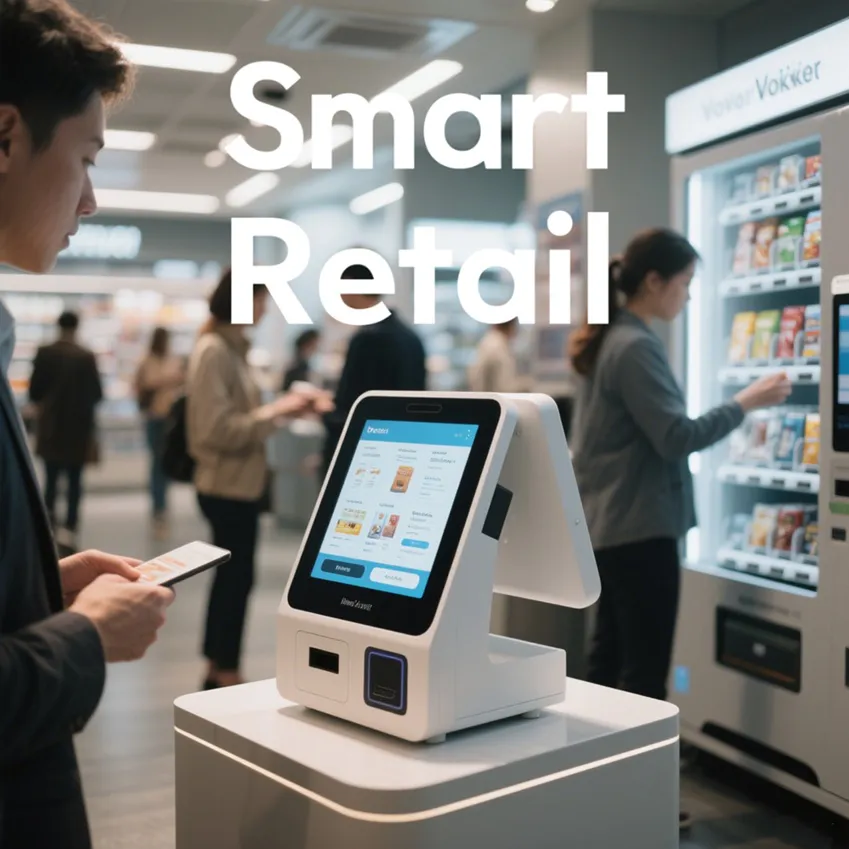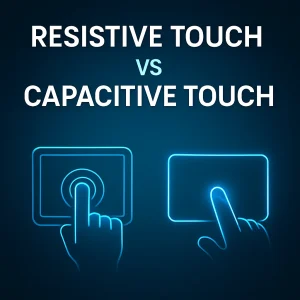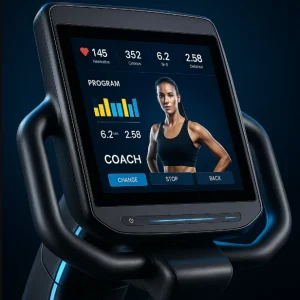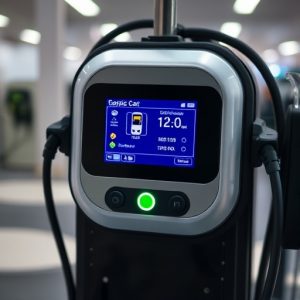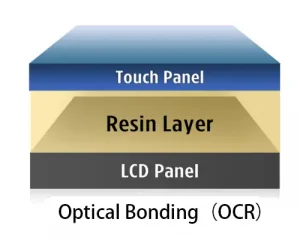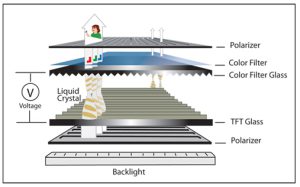As the retail industry continues to evolve, smart retail displays have become a critical component of the customer experience. From self-service kiosks to vending machines and digital signage, retailers are embracing interactive technologies to enhance engagement, reduce operational costs, and improve efficiency. These smart devices rely heavily on high-quality TFT LCDs and robust embedded SBCs (Single Board Computers) to function reliably in demanding environments.
In this article, we’ll explore how to choose the right TFT LCD for kiosk and other retail applications, and why pairing it with the right embedded Android SBC & Linux SBC is essential for developing modern retail systems.
Why Smart Retail Displays Are Essential for Customer-Facing Devices
Smart retail displays serve as the primary interface between customers and digital retail systems. Whether scanning a QR code, placing an order, or checking out, the display must offer clear visuals, fast response, and reliable touch interaction.
How Touchscreen Displays Influence Retail Interactions
The display quality directly affects the user experience. A dim, slow, or unresponsive screen ca
n result in customer frustration or even abandoned transactions. In contrast, a bright, high-resolution touch display helps users navigate intuitively and creates a premium impression of your brand.
Where Smart Retail Displays Are Used
Smart displays are widely used in:
-
Self-service kiosks
- Vending machines
-
Point-of-sale (POS) terminals
-
Digital signage and advertising displays
- Interactive guide panels
Recommended screen sizes vary by application. For example:
-
POS terminals: 5–7 inches
-
Kiosks and vending: 7–15.6 inches
-
Digital signage: 10.1 inches and above
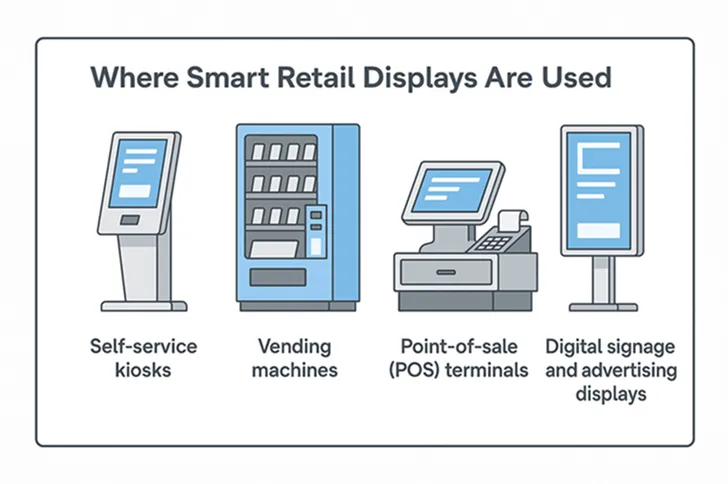
Smart-Retail-Displays-Application
Key Technical Considerations When Choosing TFT LCD for Kiosk Applications
Screen Brightness and Visibility
In retail environments—especially semi-outdoor installations like vending machines—brightness matters. TFT LCDs with ≥500 nits brightness ensure readability even under direct lighting. Wide viewing angles (using IPS or O-Film technology) allow customers to see the screen clearly from any direction.
Interface Types for Seamless Integration
Depending on the embedded system used, your display may need to support:
-
LVDS for stable, EMI-resistant transmission
-
MIPI DSI for high-speed mobile-style applications
-
HDMI for plug-and-play integration
-
RGB for basic MCU-based platforms
Selecting the right interface ensures smooth compatibility with your SBC hardware.
Durability and Touch Integration
Retail environments are public-facing. This means your display should be:
-
Scratch-resistant
-
Dust- and moisture-tolerant
-
Available with custom touchscreen display options, such as PCAP with anti-glare or anti-fingerprint coatings
Optical bonding can also improve contrast and protect against condensation.
Custom Touchscreen Display Solutions for Retail Applications
Matching the Display to the Device Housing
Most smart retail devices are integrated into custom enclosures. Choosing a custom touchscreen display allows you to align the screen dimensions, bezel fit, and cover lens thickness with your device’s industrial design.
Full Customization Services from Prototype to Mass Production
A qualified display provider can offer:
-
Interface configuration (e.g. LVDS vs. MIPI)
-
Touchscreen tuning (sensitivity, multi-point calibration)
-
Cover glass customization (logo, thickness, shape)
-
Long-term availability and batch consistency
This makes it easier to move from design to mass production without surprises.
What Makes an SBC for Smart Retail Different from a General Embedded Board?
An SBC for smart retail is not a special category of hardware, but rather a standard embedded SBC configured and applied to meet the unique demands of smart retail environments—such as kiosks, vending machines, and POS terminals.
While the core hardware may be based on a general-purpose ARM platform, deploying it in retail scenarios requires:
-
Display interface compatibility for connecting to a TFT LCD for kiosk
-
Multiple USB/UART/GPIO ports to support barcode scanners, receipt printers, payment terminals, and more
-
Touchscreen support, choosing custom touchscreen displays to meet specific design needs
-
Android/Linux operating system support for flexible application development
-
Long-term stability and 24/7 operation in high-traffic environments
In short, choosing an SBC for smart retail means selecting a board that not only meets the technical specs but also aligns with the use-case requirements of interactive, customer-facing terminals.
Hardware Requirements for Retail Applications
Retail devices often operate 24/7, in environments with variable temperature and constant user interaction. Therefore, a smart retail SBC should offer:
-
ARM-based CPU (e.g., Cortex-A55/A72)
-
Minimum 2GB RAM and 8GB eMMC
-
HDMI or MIPI/LVDS video output
-
USB 2.0/3.0 for peripherals
-
UART and GPIO for device control
-
Ethernet and optional 4G/Wi-Fi for connectivity
Boards like the embedded Android/Linux SBC with Rockchip, Allwinner, or NXP platforms are commonly used in these systems.
Why Choose an ARM-Based Embedded Android/Linux SBC for Retail Devices
Using an embedded Android/Linux SBC in smart retail brings several advantages over traditional x86 systems:
Benefits of Android/Linux SBCs
-
Lower power consumption, ideal for compact, fanless devices
-
Long lifecycle availability, supporting stable mass production
-
Native touchscreen support, enabling fluid UI interaction
-
OTA update capability, for remote software maintenance
-
Rich development ecosystem, especially for Android retail apps
These SBCs are tailor-made to work seamlessly with TFT LCD for kiosk applications, ensuring consistent performance and fast boot times.
How Display + SBC Integration Accelerates Smart Retail Deployment
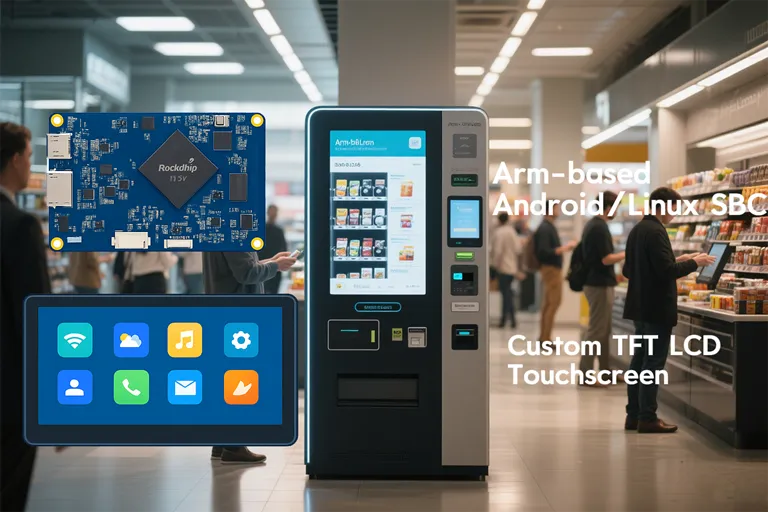
Smart-Retail-Displays-Application
Turnkey Solution Benefits
Integrating the display and SBC into a unified hardware platform can significantly streamline the development and deployment process for smart retail devices. At Rocktech, we provide a complete display + SBC solution, engineered to meet the demands of customer-facing terminals in retail environments.
Our solution includes:
-
High-quality TFT LCD modules from 1.0″ to 15.6″, with wide viewing angles, high brightness, and optional PCAP touch
-
Embedded Android/Linux SBCs with ARM architecture, supporting LVDS/MIPI/HDMI interfaces and rich I/O for retail peripherals
-
Pre-configured OS images and drivers tailored for display compatibility
-
One-stop technical support from initial design to mass production
By choosing Rocktech’s integrated Display + SBC platform, you reduce design complexity, accelerate your product development cycle, and ensure a stable, retail-ready system from day one.
Conclusion – Build Smarter Retail Devices with Integrated Displays and SBCs
The future of retail is digital, interactive, and highly personalized. Whether you’re building a POS terminal, a vending machine, or a smart kiosk, combining a reliable smart retail display with a tailored embedded Android/Linux SBC gives you a strong foundation for innovation.
With custom display options, industrial-grade SBCs, and full-stack integration support, you can accelerate development, ensure long-term reliability, and deliver a premium user experience.
Ready to Start Your Smart Retail Project?
Whether you need a TFT LCD for kiosk use or a full smart retail SBC + display solution, we’re here to help.
📩 Contact us today to request samples or discuss a custom configuration.

